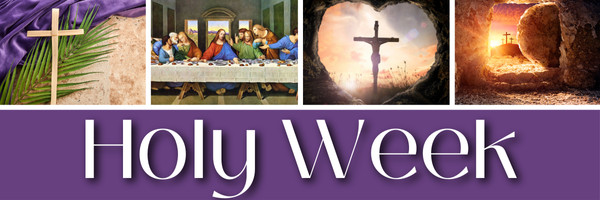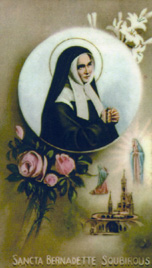We ask you, urgently: don't scroll past this
Dear readers, Catholic Online was de-platformed by Shopify for our pro-life beliefs. They shut down our Catholic Online, Catholic Online School, Prayer Candles, and Catholic Online Learning Resources essential faith tools serving over 1.4 million students and millions of families worldwide. Our founders, now in their 70's, just gave their entire life savings to protect this mission. But fewer than 2% of readers donate. If everyone gave just $5, the cost of a coffee, we could rebuild stronger and keep Catholic education free for all. Stand with us in faith. Thank you.Help Now >
Prostration and Vestments on Good Friday
FREE Catholic Classes
And More on the Precious Blood
ROME, MARCH 22, 2006 (Zenit) - Answered by Father Edward McNamara, professor of liturgy at the Regina Apostolorum university.
Q: I have a question concerning the liturgy of Good Friday. The sacramentary in use in the United States directs: "The priest and the deacon, wearing red vestments, go to the altar. There they make a reverence and prostrate themselves, or they may kneel" (Sacramentary, rev. 1985). 'Paschales Solemnitatis,' the Circular Letter Concerning the Preparation and Celebration of the Easter Feasts (Congregation for Divine Worship, 1988) directs "The priest and ministers make a reverence to the altar prostrating themselves. This act of prostration, which is proper to the rite of the day, should be strictly observed, for it signifies both the abasement of 'earthly man,' and also the grief and sorrow of the Church." These two directives seem to be contradictory to me. Do you find them contradictory? And, if so, which would take precedence? -- M.E., New York.
Why is a chasuble prescribed instead of a cope for Good Friday? -- J.C., Rochester, New York
A: The above mentioned circular letter itself clarifies the question of precedence in No. 5 of the document:
"[T]he Congregation for Divine Worship, after due consideration, thinks that it is a fitting moment to recall certain elements, doctrinal and pastoral, and various norms which have already been published concerning Holy Week. All those details which are given in the liturgical books concerning Lent, Holy Week, the Easter Triduum and paschal time retain their full force, unless otherwise stated in this document.
"It is the aim of this document that the great mystery of our redemption be celebrated in the best possible way so that the faithful may participate in it with ever greater spiritual advantage."
At first appearance there appears to be a contradiction as one document gives the option of kneeling while the other mentions only prostration.
The rubric in the new Latin Missal (2002), however, retains the option of kneeling albeit "pro opportunitate."
I would say, therefore, that rather than contradicting the Missal the circular letter wishes to stress that the two possibilities are not equal and that, from the liturgical and symbolic point of view, the preferred posture at this moment is prostration.
The option of kneeling is wisely retained as no small number of priests might find prostration to be a somewhat arduous or even hazardous task. In some cases the efforts required at getting down, and getting up again could be ungainly and distract from the overall somberness of the occasion.
With respect to the use of the chasuble: The liturgy for Good Friday prior to the reform of the Roman Missal prescribed a complex series of rites and changes of vesture.
The priest wore an alb and black stole for the entrance, prayers and Passion. He assumed a black cope for the universal prayers but left the cope aside for the Adoration of the Cross. At the time of Holy Communion he substituted the black stole for a violet one and donned a violet chasuble in order to distribute Communion.
When the rite was reformed the color red was preferred to the use of black and violet. And the rite was simplified with the use of only one kind of vestment, the chasuble, throughout the celebration. The priest removes the chasuble (and may also remove his shoes) only while kneeling to adore the Cross.
The chasuble was probably preferred to the cope as a more suitable vestment for the distribution of Communion and perhaps also for practical purposes as many poor parishes would find it difficult to purchase a red cope to be used perhaps once or twice a year.
* * *
More on Reserving the Precious Blood
Some hospital chaplains said that my suggestion -- that ideally the priest would be able to celebrate at the house or hospital -- was impractical.
Of course, my suggestion supposes optimal conditions, which rarely occur in real life. Nevertheless, this does not detract from the fact that this would be the best possible solution.
Another chaplain proposed that my conclusion, that "'it is not correct to reserve the Precious Blood,' does not fully reflect the nuance you had noted from Canon 925 and the Rites of Anointing and Viaticum." He also states: "Viaticum is, of course, the proper sacrament for the dying; but our practice has denied this, making the anointing of the sick into the sacrament for the dying."
He and some other chaplains explain that they do often reserve the Precious Blood in order to be prepared for emergency situations such as late night calls when the celebration of Mass is impossible.
The 1967 instruction "Eucaristicum Mysterium," which forms the basis for the rubrics of the rite of viaticum, indicated the following in No. 41 under the heading, "Communion under the Species of Wine Alone":
"In case of necessity, depending on the judgment of the bishop, it is permitted to give the Eucharist under the species of wine alone to those who are unable to receive it under the species of bread. [Since 1972 the judgment of the local bishop in each case is no longer required.]
"In this case it is permissible, with the consent of the local Ordinary, to celebrate Mass in the house of the sick person.
"If, however, Mass is not celebrated in the presence of the sick person, the Blood of the Lord should be kept in a properly covered chalice and placed in the tabernacle after Mass. It should be taken to the sick person only if contained in a vessel which is closed in such a way as to eliminate all danger of spilling. When the sacrament is administered, that method should be chosen from the ones given in the Rites for Distribution of Communion under Both Kinds which is most suited to the case. When Communion has been given, should some of the precious Blood still remain, it should be consumed by the minister; he will also carry out the usual ablutions."
Thus, while these priests show authentic zeal and spirit of self-sacrifice, as well as a deep desire to facilitate Communion to as many sick and dying people as possible, I think that the norms permitting a temporary reservation of the Precious Blood clearly imply a specific and concrete personal need.
Thus, I do not believe that the present norms permit the habitual reservation of the Sanguis in order to be ready for an emergency situation.
At the same time, advances in medicine have probably greatly increased the number of people who survive for quite some time in conditions where they could only be able to receive Communion under the species of wine.
In hospitals where their number is significant, and where, due to circumstances, either the priest cannot celebrate daily or else cannot administer Communion to all those needing it in a reasonable time, then the above norm would probably permit reserving the Precious Blood overnight or for a few days.
Since such pastoral situations are likely to augment, it would be desirable that either the Holy See or bishops' conferences propose specific norms as to the mode of reservation and administration so as to avoid any danger of profanation or lack of respect.
A very different situation was brought to light by several readers who reported that several parishes reserve the Precious Blood on Holy Thursday.
One wrote: "I have been in several churches which do display the Precious Blood on Holy Thursday evening for adoration along with the consecrated hosts. Is it sinful for me to thus adore the Precious Blood that is displayed in this way?"
As we mentioned, except for medical emergencies, it is not permitted to reserve the Precious Blood -- and Holy Thursday is no exception.
In line with long-standing tradition, when Communion is given (and until about 50 years ago it was not given) on Good Friday, it is distributed under the species of bread alone.
Besides, the manner of reservation described by our correspondent compounds the error because, for all practical purposes, we have an exposition of the Blessed Sacrament which is expressly forbidden on Holy Thursday and Good Friday.
While one could hardly be described as sinning by adoring the Lord, it would be worthwhile for our correspondent to express his doubts to the parish priest and if necessary to the bishop.
Finally, a New York reader wrote describing a rather unusual occurrence: "Last Sunday the celebrant consecrated the wine in the glass pitcher. Not all of the Precious Blood was consumed during the Mass and so needed to be consumed during the purification of the vessels in the sacristy following Mass. Our associate told me that if we just added more unconsecrated wine to the Precious Blood existing in the pitcher, then the Precious Blood would now be more wine than Blood and we could use it at the next Mass. I told him I had never heard that. He assured me that it was taught at the seminary. I consumed Jesus anyway and told the associate I would write you. Please advise. I certainly do not want to challenge a priest but do not want to promulgate error."
Apart from the fact that the norms issued by both the Holy See and the U.S. bishops no longer allow wine to be consecrated in a flagon or pitcher, but in several chalices, I would say the following:
The priest is theologically correct in saying that the addition of excess unconsecrated wine would remove the Lord's real presence. (See our commentary in follow-ups on May 13 and July 5, 2005.)
To do so, however, is at the very least a grave lack of respect and, if done with full awareness of its gravity, more than likely an act of sacrilege.
The norms we quoted last time are very clear: All of the Precious Blood must be consumed as soon as Communion is over and before the end of Mass, and thus not left until the purification of the vessels after Mass.
Great care should be taken regarding the quantity so that no Precious Blood should be left over after Mass.
Contact
Catholic Online
https://www.catholic.org
CA, US
Catholic Online - Publisher, 661 869-1000
info@yourcatholicvoice.org
Keywords
Good Friday, Prostration, Vestments, McNamara, Mass, Altar
More Catholic PRWire
Showing 1 - 50 of 4,716
A Recession Antidote
Randy Hain
Monaco & The Vatican: Monaco's Grace Kelly Exhibit to Rome--A Review of Monegasque-Holy See Diplomatic History
Dna. Maria St. Catherine Sharpe, t.o.s.m., T.O.SS.T.
The Why of Jesus' Death: A Pauline Perspective
Jerom Paul
A Royal Betrayal: Catholic Monaco Liberalizes Abortion
Dna. Maria St.Catherine De Grace Sharpe, t.o.s.m., T.O.SS.T.
Embrace every moment as sacred time
Mary Regina Morrell
My Dad
JoMarie Grinkiewicz
Letting go is simple wisdom with divine potential
Mary Regina Morrell
Father Lombardi's Address on Catholic Media
Catholic Online
Pope's Words to Pontifical Latin American College
Catholic Online
Prelate: Genetics Needs a Conscience
Catholic Online
State Aid for Catholic Schools: Help or Hindrance?
Catholic Online
Scorsese Planning Movie on Japanese Martyrs
Catholic Online
2 Nuns Kidnapped in Kenya Set Free
Catholic Online
Holy See-Israel Negotiation Moves Forward
Catholic Online
Franchising to Evangelize
Catholic Online
Catholics Decry Anti-Christianity in Israel
Catholic Online
Pope and Gordon Brown Meet About Development Aid
Catholic Online
Pontiff Backs Latin America's Continental Mission
Catholic Online
Cardinal Warns Against Anti-Catholic Education
Catholic Online
Full Circle
Robert Gieb
Three words to a deeper faith
Paul Sposite
Relections for Lent 2009
chris anthony
Wisdom lies beyond the surface of life
Mary Regina Morrell
World Food Program Director on Lent
Catholic Online
Moral Clarity
DAN SHEA
Pope's Lenten Message for 2009
Catholic Online
A Prayer for Monaco: Remembering the Faith Legacy of Prince Rainier III & Princess Grace and Contemplating the Moral Challenges of Prince Albert II
Dna. Maria St. Catherine Sharpe
Keeping a Lid on Permissiveness
Sally Connolly
Glimpse of Me
Sarah Reinhard
The 3 stages of life
Michele Szekely
Sex and the Married Woman
Cheryl Dickow
A Catholic Woman Returns to the Church
Cheryl Dickow
Modernity & Morality
Dan Shea
Just a Minute
Sarah Reinhard
Catholic identity ... triumphant reemergence!
Hugh McNichol
Edging God Out
Paul Sposite
Burying a St. Joseph Statue
Cheryl Dickow
George Bush Speaks on Papal Visit
Catholic Online
Sometimes moving forward means moving the canoe
Mary Regina Morrell
Action Changes Things: Teaching our Kids about Community Service
Lisa Hendey
Easter... A Way of Life
Paul Spoisite
Papal initiative...peace and harmony!
Hugh McNichol
Proclaim the mysteries of the Resurrection!
Hugh McNichol
Jerusalem Patriarch's Easter Message
Catholic Online
Good Friday Sermon of Father Cantalamessa
Catholic Online
Papal Address at the End of the Way of the Cross
Catholic Online
Cardinal Zen's Meditations for Via Crucis
Catholic Online
Interview With Vatican Aide on Jewish-Catholic Relations
Catholic Online
Pope Benedict XVI On the Easter Triduum
Catholic Online
Holy Saturday...anticipation!
Hugh McNichol
Join the Movement
When you sign up below, you don't just join an email list - you're joining an entire movement for Free world class Catholic education.

-

- Stations of the Cross
- Easter / Lent
- 5 Lenten Prayers
- Ash Wednesday
- Living Lent
- 7 Morning Prayers
- Mysteries of the Rosary
- Litany of the Bl. Virgin Mary
- Popular Saints
- Popular Prayers
- Female Saints
- Saint Feast Days by Month
- Pray the Rosary
The Sacred Triduum: Holy Thursday, Good Friday and Easter. The Mystery of Faith
The Silent Love of Holy Thursday
UK Supreme Court Stands Firm, ‘Woman’ Means Biological Female
Daily Catholic
 Daily Readings for Thursday, April 17, 2025
Daily Readings for Thursday, April 17, 2025 St. Anicetus: Saint of the Day for Thursday, April 17, 2025
St. Anicetus: Saint of the Day for Thursday, April 17, 2025 Prayer to Love God above all Things: Prayer of the Day for Thursday, April 17, 2025
Prayer to Love God above all Things: Prayer of the Day for Thursday, April 17, 2025 Daily Readings for Wednesday, April 16, 2025
Daily Readings for Wednesday, April 16, 2025 St. Bernadette: Saint of the Day for Wednesday, April 16, 2025
St. Bernadette: Saint of the Day for Wednesday, April 16, 2025- Prayer for our Family #1: Prayer of the Day for Wednesday, April 16, 2025
![]()
Copyright 2025 Catholic Online. All materials contained on this site, whether written, audible or visual are the exclusive property of Catholic Online and are protected under U.S. and International copyright laws, © Copyright 2025 Catholic Online. Any unauthorized use, without prior written consent of Catholic Online is strictly forbidden and prohibited.
Catholic Online is a Project of Your Catholic Voice Foundation, a Not-for-Profit Corporation. Your Catholic Voice Foundation has been granted a recognition of tax exemption under Section 501(c)(3) of the Internal Revenue Code. Federal Tax Identification Number: 81-0596847. Your gift is tax-deductible as allowed by law.







 Daily Readings for Thursday, April 17, 2025
Daily Readings for Thursday, April 17, 2025 St. Anicetus: Saint of the Day for Thursday, April 17, 2025
St. Anicetus: Saint of the Day for Thursday, April 17, 2025 Prayer to Love God above all Things: Prayer of the Day for Thursday, April 17, 2025
Prayer to Love God above all Things: Prayer of the Day for Thursday, April 17, 2025 St. Bernadette: Saint of the Day for Wednesday, April 16, 2025
St. Bernadette: Saint of the Day for Wednesday, April 16, 2025


